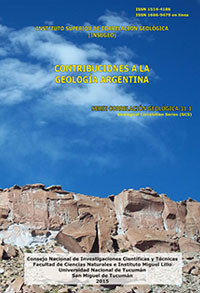Serie Correlación Geológica 31 (1)
La “Fase Oclóyica”(Ordovícico Superior) en el noroeste argentino. Interpretación histórica y evidencias en contrario
Descargar trabajo en formato PDFResumen
LA “FASE OCLÓYICA” (ORDOVÍCICO SUPERIOR) EN EL NOROESTE ARGENTINO. INTERPRETACIÓN HISTÓRICA Y EVIDENCIAS EN CONTRARIO. Se discute el marco conceptual en el que fue definida la “Fase Oclóyica” en el norte argentino, marco que se modificó no sólo por la introducción de nuevos conceptos aportados por la tectónica de placas y la estratigrafía de secuencias, sino por la creciente información radiométrica y bioestratigráfica, que permitió ajustar la edad de los principales eventos geológicos ocurridos durante el Paleozoico inferior en esta región. La discusión se inicia con el análisis de la discordancia que marca el techo del Grupo Santa Victoria (Furongiano superior - Ordovícico Superior), cuya génesis fue atribuida al tectonismo de la “Fase Oclóyica”, evento tradicionalmente considerado como el responsable del plegamiento de los depósitos ordovícicos en el norte argentino. Se muestran evidencias que se contraponen con tal interpretación y se brindan hipótesis alternativas respecto de los tiempos de deformación de las secuencias ordovícicas de la región.
Abstract
THE “OCLOYIC PHASE” (UPPER ORDOVICIAN) IN THE ARGENTINE NORTHWESTERN. HISTORICAL INTERPRETATION AND EVIDENCE AGAINST. The conceptual framework in which was defined the “Ocloyic Phase” in the Argentine Northwestern is discussed. This conceptual framework was modified not only by the introduction of new concepts contributed by plate tectonics and sequence stratigraphy, but by the increasing radiometric and biostratigraphic information, which allowed to adjust the age of the major geological events that occurred during the lower Paleozoic in this region. The discussion begins with an analysis of the unconformity that marks the top of the Santa Victoria Group (Upper Furongian - Upper Ordovician), whose genesis was attributed to the “Ocloyic Phase” tectonism, event that was traditionally considered responsible for the folding of the Ordovician deposits in northern Argentina. Evidences that contradict this interpretation are shown and alternative hypotheses are provided about the deformation times of the Ordovician sequences in the region.






